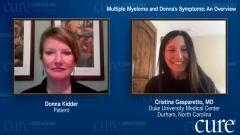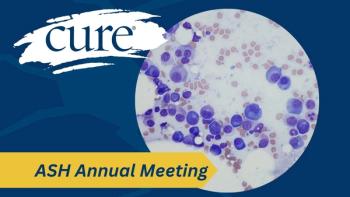
Donna’s Multiple Myeloma Transplants and Chemotherapy
We learn more about Donna’s 2 transplants, her chemotherapy, and how they impacted her quality of life.
Episodes in this series

Cristina Gasparetto, MD: The transplant remains very important. I always tell patients that it’s a way to give chemotherapy all at once and kill the myeloma. But there’s a very good, deep penetration, and a lot of patients were able to achieve that minimal residual disease with transplant. Then they go maintenance, and we see long duration of responses with that approach. That’s why we still recommend, in some transplants—even the newer transplant study was conducted with this new targeted therapy—showing the deductive response that we achieve with transplant is probably even better.
Some patients, for many reasons, decide not to do the transplant. But it’s always important to collect the stem cells earlier so you can stay on therapy, try to achieve the depth of the response with continuation of therapy. But when the myeloma comes back, you’re ready to go with the transplant. I always recommend transplant earlier, as you did, because the duration of response for your quality of life is very important. If you can stay in remission for five years, which is now the average with the maintenance, or even longer—I have patient who has been in remission for 10 years—what’s wrong with that, right? You’re off therapy; you’re on maintenance. But the transplant scares a lot of patients. What did you go through during the transplant? Were you really sick?
Donna Kidder: Yeah, I was really weak. For me, that’s hard. I had typical chemotherapy responses: weak, feverish, temperatures.... But in about two weeks I turned the corner. I was determined. When I got this, I didn’t want it to be five years down the road and regretting not having taken that option. All along, I’ve done whatever offered me the most progression-free period of time. My transplants gave me that, as you said. I had 4 ½ years of a completely normal life. Outside of being checked for the cancer, I was leading a completely normal life. Just enjoying my grandkids, traveling, cycling, running—you name it. It was absolutely worth it to me.
Cristina Gasparetto, MD: That’s the most important point. For the majority of patients, we’re giving high-dose chemotherapy. Then we rescue you with your own stem cells. You’re sick for two weeks, right? You can have fever, you may require antibiotics, transfusion. But at the end of the two weeks, your counts start to recover. It takes another few months to go back to your baseline, but then you’re disease-free. The majority of patients are able to go to a maintenance therapy. The standard maintenance is lenalidomide by mouth at a low dose. You can keep traveling, enjoying activities and life. To me, quality of life is very important. Like you, Donna, I like the duration, the freedom of not being attached to continuation of therapy.
Donna Kidder: Right.
Cristina Gasparetto, MD: Do you have any specific advice or comments for another patient who’s ready to go to transplant? What do you think?
Donna Kidder: The most important things that people told me—people are very willing to talk to me about what to expect—is that it’s going to be hard, but you’re going to get through it. It’s a short duration, and on the other end you have your life in front of you. You have this period of time where you’re just going to be able to pretend that you don’t even have cancer.
Cristina Gasparetto, MD: And you don’t… You know it might come back; you don’t know when. But you’re pushing it for many years.
Donna Kidder: Yes. People told me that they’d gotten through it and were fine, and now their numbers are great. And they’re progressing with their lives. That kind of encouragement inspired me to dig down and get through it. As I said, two weeks. I can handle anything for two weeks. I used to run marathons.
Cristina Gasparetto, MD: Yeah.
Donna Kidder: Patience and perseverance.
Cristina Gasparetto, MD: Exercising is so important. That’s when you’re in the lowest point of your treatment, that recovery time. And you’re right: It’s like running a marathon. But then at the end of that, you know that there is the end. This is your initial chemotherapy combination. Your transplant. Even if you had two transplants, that’s called the first-line therapy.
Donna Kidder: Right.
Cristina Gasparetto, MD: Some patients will not have the transplant but will have continuation. But the goal for both approaches is the same. To achieve, as you mentioned, the minimal residual disease, the complete remission. It’s clear that that’s the goal, and I like to monitor my patients. I call this sequential minimal residual disease checking, where I make sure they’re really in remission. Fortunately, that will involve a bone marrow. And bone marrow is not like your favorite test in the world. We’re getting better with that too. But if you know the reward is maintaining that remission, which is very important. We learned over the last decade or more that even if you’re in remission, keeping ongoing maintenance is also very important. The data are clear: If you’re on maintenance after initial therapy, you stay in remission longer.
This transcript has been edited for clarity.






